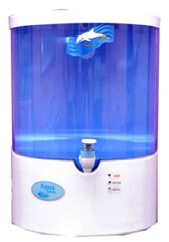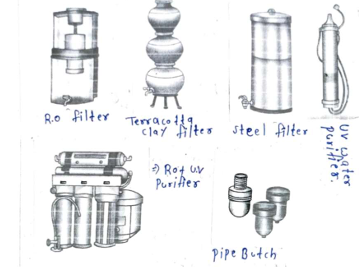Name of the activity:
To study the design and function of any one of the water purification devices for
domestic use.
Purpose/Importance of the activity:
The purpose of the studying the RO purifier is to understand its role in providing
clean drinking water at home , ensuring a healthy lifestyle.
Propose time duration of the activity:
Approximately 48 hours.
Materials and apparatus required for the activity:
RO purifier unit , water samples , testing kits , PH meter ,TDS meter , containers ,
microscope , laboratory notebook.
Methodology of the activity:
i) Delved into the principal of RO purifier, understanding how they function purify water.
ii) Utilised pH strips and a TDS meter to establish the initial water parameter, ensuring a
comprehensive understanding of the starting conditions.
iii) Past each water sample through the RO purifier carefully observing and documenting
the changes in test clarity and overall quality.
iv) Conducted through examination of the purified water measuring final PH and TDS
levels to evaluate the effectiveness of the RO filters.
v) Detailed observation on the taste, odour, and visual characteristics of the water after
purification, noting any noticeable improvements or changes.
vi) Recorded the duration required for the RO purifier to complete the water purification
process, assessing its efficiency.
vii) Utilized collected data to draw comparison between the different water sources and
assess the overall performance of the RO purifier.
viii) Shed findings with classmates, encouraging a collaborative exploration of the results
and facilitating a deeper understanding.
ix) Developed a comprehensive presentation summarising the experiment, incorporating
visuals aids and key points for effective communication.
x) Documented key learnings, perimental procedures and results in detailed reports
ensuring a comprehensive overview of the study.
xi) Presented insights and findings to the class, fostering discussion and allowing for
typhoids perspective on the significance of water purification.
Diagrams/photographs of the activity:

Concepts Learnt During the Activity :
i) RO purifiers use a semi-permeable membrane to remove impurities.
ii) Understanding the multi-stage purification process.
What New Things Did You Learn ?
i) Explored the importance of microscopic analysis for unseen contaminants .
ii) Explored the impact of pH and TDS on water quality .
iii) Learned about the advanced technology involved in RO purifier.
Conclusion :
i) The RO purifier significantly improved water quality .
ii) Regular upkeep is vital for sustained performance .
iii) Access to purified water positively affects overall well-being .
Your Own Opinion / Experience About the Activity :
i)Practical experience enhanced understanding.
ii) Encountered challenges deepened problem skills .
Cooperation from the parents:
i) Parents provided valuable guidance during the study.
ii) Helping in acquiring materials and facilitating the experiment.
Opinion of the parents:
i) Acknowledged the educational significance of the study.
ii) To recognise the importance of ensuring clean water for the family.
Persons who have helped you :
Science teacher provided guidance on experimental setup
and methodology.
List of reference materials :
i) Classroom notes on water purification.
ii) Online resources on RO purifiers.
iii) Conservations with the science teacher.
Ans.
Identify and label some of the household water purification devices given below.
i) RO filter utilize a semi-permeable membrane to purify water by removing impurities , ensuring a cleaner and safer drinking supply.
ii) Terracotta clay filters leverage natural clay's porous structure to filter impurities , providing a sustainable and traditional method for purifying water.
iii) UV purifiers use light for microorganism deactivation , ensuring chemical-free water disinfection.
iv) Steel filters use stainless steel mesh to seive impurities.
photographs of the Sub-activity
